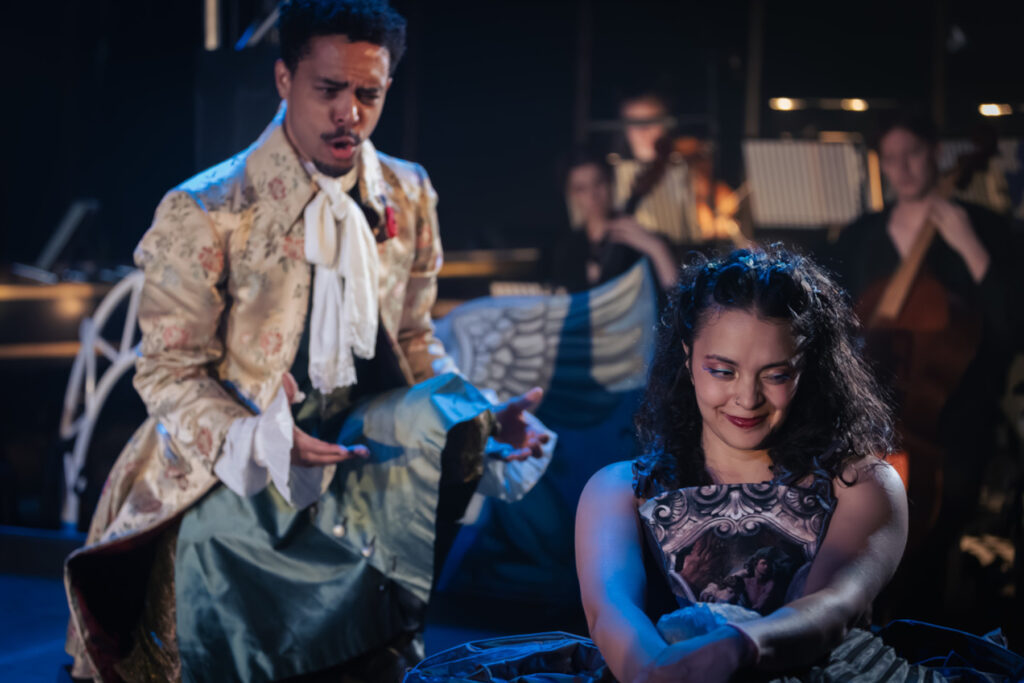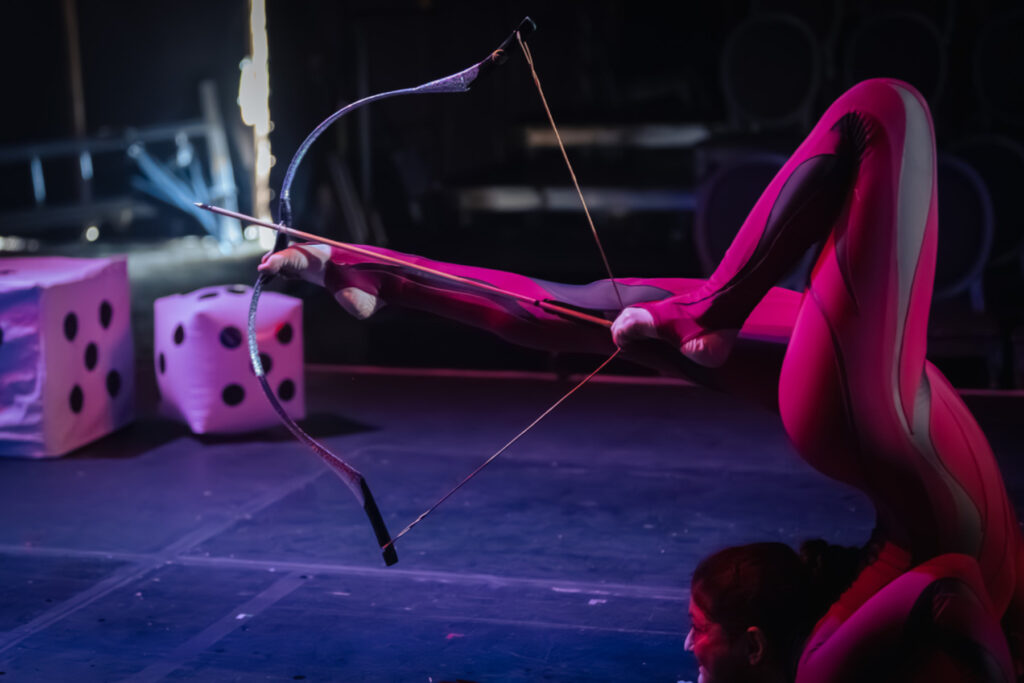First performed on January 20, 1699, André Campra’s comic opera/ballet to a libretto by Jean-François Regnard finally arrives at its UK premiere in late Summer 2025 at the Vache Baroque Summer Festival. It is sung in French, Italian and English, a heady mix and a real test (successfully passed) for the singers.
All this happened against the backdrop of the Chiltern Hills, a short journey from Chalfont & Latimer station. La Vache Baroque started five years ago, founded by Betty Makharinsky and the Music director for these performances, Jonathan Darbourne. This is a properly celebratory extravaganza: director James Hurley has referred to the opera as a “genre-bending blend of comedy and tragedy”. The action takes place over the course of one day of Venice’s famous carnival; the opera also includes a play-within-a play (Orpheus in the Underworld; an idea not a million miles from Shakespeare’s Mechanicals in A Midsummer Night’s Dream, just with layers and layers of camp ladled on). We can make other parallels (and pre-echoes), too. The Prologue is set backstage, with a stage manager nagging away because the staging of Orpheus is so behind. Ariadne auf Naxos with a French Baroque accent (sung, though, in English) seems to be an unavoidable link; but here, the Goddess Minerva arrives into the world of Muggles, shocked by the chaos. She calls on the Muses of Music, Dance, Painting and Architecture to help. Inevitably, as the opera proceeds, love entanglements come forward. And how.

The heart of the Italian commedia dell’arte is here in James Hurley’s production, as are Venetian masks and, of course, gondola. The “inserted opera” is sung in Italian; French predominates elsewhere, apart from that English Prologue. Quite right, then, that this should be set in a (circus) tent, almost in the round (audience on three sides, band on the fourth). It is pretty immersive, although the audience are told to be as still as possible because of the acrobatics. Before the production started, two violinists (Naomi Burrell and Charlotte Faibairn) started playing duets in the grounds; warm-ups? Kind of, but warm-ups for the event, not themselves – the same players became part of the performance onstage, and the music director, Jonathan Darbourne, conducted the opera’s close from the stage, held aloft by the singers.
After the havoc of the Prologue, the first act is set in the Piazza di San Marco, Venice. Léonore (yes, another one) has lost the interest of her lover, Léandre, who has been juggling both Léonore and Isabelle. Confronting him, the two girls force him to make a choice; Isabelle is the chosen one. A commedia dell’arte troupe sings songs about love and Venice. In the second act, we have another complication: Rodolphe (a Venetian nobleman) also loves Isabelle. Together with Léonore, the two plot revenge against Léandre. There follows a brilliant scene of mistaken identities and admissions of love, but to the wrong person.

With the third act, everyone believes Léandre is dead (of course he’s not). Mourning and near-suicide clarify Isabelle’s feelings, so that when Léandre appears, nicely alive after a botched assassination attempt, Isabelle is crystal clear of her feelings. They can leave while the entire city of Venice is distracted by the opera’s final part, a setting of Orfeo in an Italian Underworld.
With such a plot and placement, contortionist acts and contortionist archery seem perfect: Hannah Finn lists herself as a “circus performer and high-level contortionist” and she’s not kidding. Such is the pull of the production, though, that her remarkable what I can only call “bendiness” seems a natural part of the show.
So in amongst all the unbelievable events is love. There is chaos galore. Minerva is brilliantly taken by Katie Bray (who also sings Léonore), who rips up a play’s script just as the curtain is going up. The Prologue contains the essence of the opera, including dance (a nice sprightly Passepied from the scaled-down band). Campra’s music shifts emphasis immediately for Act One and Léonore’s plaint of regret (“J’ai fait l’aveu de l’ardeur qui m’enflame”). This music and mezzo Katie Bray’s voice are made for each other,
Julieth Lozano takes the role of Isabelle, her act three lament, “Mes yeux, fermez-vous à jamais” beautifully touching. I was very taken by bass-baritone Tristan Hambleton’s strong Rodolphe (the Venetian nobleman in love with Isabelle who plays such a part in the second act), while Giuseppe Pellingra was a superbly authoritative (as far as the campness allowed) Plutone, if not quite so confident vocally. Themba Mvula sang Léandre. This is a central character, but his dramatic presence seemed lower voltage than those around him; vocally, too, he was less secure. Feargal Mostyn-Williams was an excellent Orfeo, Eleanor Bromfield a fine La Fortune.
The lighting (Ben Pickersgill) is superb, perfectly calibrated to a work that shift emphasis and tone on a sixpence, ever supporting the prevailing mood, from the distraught to the extravagant. Director James Hurley and designer Laura Jane Stanfield have created miracles with the space and budget at his disposal, given Campra’s quixotic changes of scene and mood.
A fabulously inventive staging, well sung and supported by a group of ten players of extraordinary stamina.
Colin Clarke
Le Carnaval de Venise
Composer: André Campra
Libretto: Jean-François Regnard
Cast and production staff:
Léonore – Katie Bray; Isabelle – Julieth Lozano; Rodolphe – Tristan Hambledon; Léandre – Themba Mvula; Plutone – Giuseppe Pellingra; La Fortune, Soprano Chorus – Eleanor Broomfield; Orfeo, Alto Chorus – Feargal Mostyn-Williams; Le Chef des Castellans, Tenor Chorus – William Searle; Un Musicien, Bass Chorus – Adam Jarman; Circus Artists – Hannah Finn, Shane Hampden
Director – James Hurley; Designer – Laura Jane Stanfield; Lighting Designer – Ben Pickersgill; Sound – Dom Harter, Simon Honeywill (for Martin Audio); Associate Director – Rebecca Solomon.
Music Director/Harpsichord – Jonathan Darbourne; Musicians of Vache Baroque
The Vache, Chalfont St Giles, Buckinghamshire, 31 August 2025
All photos © Vache Baroque